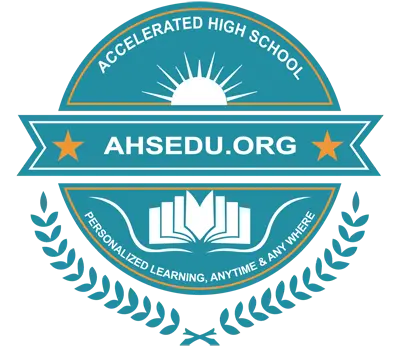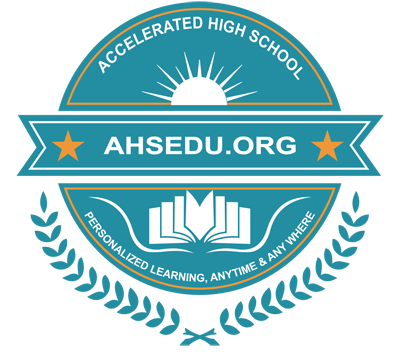Accelerated High School
Standardized Curriculum of Computer Science-IV
In the 21st century, computer science and technology have become integral to our daily lives. Understanding these concepts is crucial for everyone. Learning about computer science means grasping how computers can solve problems and create innovative solutions, such as apps and games. It empowers individuals to think critically about pertinent issues affecting society, including cybersecurity and the ethical implications of artificial intelligence (AI). Through exploring concepts like 3D modeling, students gain insights into cutting-edge technologies shaping our world. By acquiring these skills, students are equipped to navigate the digital landscape responsibly and contribute meaningfully to decision-making processes, from internet safety protocols to addressing global challenges through technology.
Mission:
All students learn the basics of cybersecurity in a child-friendly manner, basic spreadsheet concepts, the basic concepts of 3D printing, the basics of artificial intelligence, and the understanding of digital citizenship. The instruction focuses on developing an understanding of computers and the new approaches necessary to solve critical challenges that we, as American citizens, will need to harness the power of computing technology. Rapidly changing technologies and the proliferation of digital information have permeated and radically transformed learning, working, and everyday life. To be well-educated, globally-minded individuals in a world where computing technology is essential, students must have a clear understanding of computer science concepts and practices.
The study of these disciplines focuses on a deep understanding of concepts that enable students to think critically and systematically about leveraging technology to solve local and global issues. Authentic learning experiences that enable students to apply content knowledge, integrate concepts across disciplines, and develop computational thinking skills. All students have equitable access to a rigorous computer science education. Students will benefit from opportunities to engage in high-quality technology programs that foster their ability to develop and apply computational thinking to address real-world problems and design creative solutions.
Vision:
Prepare students to become technologically literate individuals who can effectively:
- Introduction to Cybersecurity: Learn the basics of cybersecurity to understand how to protect personal information and stay safe online.
- Basic Spreadsheet Skills: Develop foundational skills in using spreadsheets for data organization and analysis.
- 3D Modeling: Explore basic 3D modeling techniques and their applications in various fields.
- Artificial Intelligence (AI): Gain an understanding of AI concepts and how AI is used in everyday life.
- Digital Citizenship and Online Ethics: Learn about digital citizenship and the importance of ethical behavior online.
- Coding, Game Making, and Programming Languages: Engage in coding activities, learn game-making principles, and explore different programming languages.
This vision aims to equip students with essential technological skills and knowledge to thrive in a digitally connected world.
Spirit and Intent:
The curriculum at Accelerated High School (AHS) is designed to align closely with several educational standards, including the New Jersey Student Learning Standards for Computer Science (NJSLS-CS) introduced in 2023, the Student Learning Standards for Career Readiness, Life Literacies, and Key Skills, as well as the Student Learning Standards for Personal Financial Literacy and the New Jersey Preschool Teaching and Learning Expectations. This comprehensive alignment ensures that students receive a well-rounded education that covers computer science concepts and their real-world applications.
In this curriculum, students explore the basics of cybersecurity in a child-friendly manner, learning about password safety, creating strong passwords, online privacy, and the importance of keeping personal information secure. Basic spreadsheet skills are introduced, where students learn to input data into cells, create simple tables, perform basic calculations, and use spreadsheets to organize information and solve simple problems. The curriculum includes an introduction to 3D modeling, where students explore basic concepts using child-friendly software, create simple 3D shapes and objects, and understand the applications of 3D modeling in various fields.
Additionally, students are introduced to artificial intelligence (AI), exploring its basics, and applications in daily life and industries, and discussing ethical considerations and potential impacts. Digital citizenship and online ethics are emphasized, deepening students' understanding of responsible online behavior, ethical considerations, the impact of digital footprints, and case studies on digital ethics. Game making is also part of the curriculum, where students create clicker games, add sprites and backdrops, record sounds, use arrow keys, and add effects.
Furthermore, students learn programming languages such as Python and Ruby, providing them with the skills to develop and understand software. By aligning with these state standards, AHS provides students with access to a wide range of practice questions carefully crafted to address each specific standard. This approach facilitates effective learning and helps students master essential skills, equipping them with the knowledge necessary to thrive as well-educated, globally-minded individuals in a world where computing technology is essential.
Three Dimensions of AHS Science Curriculum:
At Accelerated High School (AHS), our science curriculum is guided by three key dimensions to reflect students' knowledge and abilities. These dimensions align with the New Jersey Student Learning Standards for Computer Science (NJSLS-CS) and promote meaningful, cumulative, and progressive learning experiences.
Computer Science Core Idea
|
Disciplinary Core Idea |
Performance Expectation |
|
Understand Basic Computer Concepts |
Identify different parts of a computer and their purposes. |
Computer Science and Engineering Practice
|
Computer Science and Engineering Practice |
Performance Expectation |
|
Engage in Discussions and Investigations |
Participate in computing and internet safety discussions. Conduct investigations to generate evidence-based claims. |
Crosscutting Concept
|
Crosscutting Concept |
Performance Expectation |
|
Adapt to New Technologies |
Learn about new technologies and how to use them. |
Our curriculum ensures students engage actively in learning beyond just reading about coding concepts. For instance, they explore cybersecurity basics, understanding password safety, and online privacy. They develop spreadsheet skills, learning to input data, create tables, and perform basic calculations. They are introduced to 3D modeling and artificial intelligence, learning to create 3D shapes, and understanding AI applications and ethics.
Students also delve into digital citizenship, responsible online behavior, and the impact of digital footprints. They engage in game-making, adding sprites, backdrops, sounds, and effects. By learning programming languages like Python and Ruby, students build a strong foundation in software development. By participating in these cumulative and progressive experiences, students enhance their understanding of computer science and improve their problem-solving and explanatory skills, preparing them to thrive in a technology-driven world.
Curriculum for Grade-IV Computer Science:
Standard 1. Cybersecurity
Learning objectives:
- Distinguishing between public and private information is important for safe and secure online interactions.
- Information can be protected using various security measures (i.e., physical and digital).
- Computing technology has positively and negatively changed the way individuals live and work (e.g., entertainment, communication, productivity tools).
Topics of AHS-CS:
A. Introduction to Cybersecurity
- Explore the basics of cybersecurity in a child-friendly manner.
- Learn about the importance of password safety and creating strong passwords.
- Understand the concept of online privacy and the importance of keeping personal information secure.
Standard 2. Spreadsheet Skills
Learning objectives:
- Computing devices interpret and follow the instructions they are given
- Individuals collect, use, and display data about individuals and the world around them.
- Computers store data that can be retrieved later. Data can be copied, stored in multiple locations, and retrieved.
- A sequence of steps can be expressed as an algorithm that a computer can process.
Topics of AHS-CS:
B. Basic Spreadsheet Skills
- Introduce basic spreadsheet concepts.
- Learn to input data into cells.
- Learn to create simple tables.
- Learn to perform basic calculations.
- Explore how spreadsheets can be used to organize information.
- Explore how spreadsheets can be used to solve simple problems.
Standard 3. 3D Modeling
Learning objectives:
- A variety of control structures are used to change the flow of program execution (e.g., sequences, events, loops, conditionals).
- Programs can be broken down into smaller parts to facilitate their design, implementation, and review.
- Programs can also be created by incorporating smaller portions of programs that already exist.
Topics of AHS-CS:
B. Introduction to 3D Modeling
- Explore basic 3D modeling concepts using child-friendly software.
- Learn to create simple 3D shapes and objects.
- Understand how 3D modeling is used in various fields.
Standard 4. Artificial Intelligence
Learning objectives:
- People work together to develop programs for a purpose, such as expressing ideas or addressing problems.
- Various tools can improve daily tasks and quality of life.
- Computer networks can be used to connect individuals to other individuals, places, information, and ideas. The Internet enables individuals to connect with others worldwide.
- Connecting devices to a network or the Internet provides great benefits, but care must be taken to use authentication measures, such as strong passwords, to protect devices and information from unauthorized access.
Topics of AHS-CS:
D. Introduction to Artificial Intelligence (AI)
- Introduce the basics of artificial intelligence.
- Explore the applications of AI in daily life and industries.
- Discuss ethical considerations and potential impacts of AI.
Standard 5. Online Ethics
Learning objectives:
- Computing technology has positively and negatively changed the way individuals live and work (e.g., entertainment, communication, productivity tools).
- Computer networks can be used to connect individuals to other individuals, places, information, and ideas. The Internet enables individuals to connect with others worldwide.
- Connecting devices to a network or the Internet provides great benefits, but care must be taken to use authentication measures, such as strong passwords, to protect devices and information from unauthorized access.
- Information can be protected using various security measures (i.e., physical and digital)
- Distinguishing between public and private information is important for safe and secure online interactions.
Topics of AHS-CS:
E. Digital Citizenship and Online Ethics
- Deepen understanding of digital citizenship.
- Discuss responsible online behavior and ethical considerations.
- Discuss the impact of digital footprints.
- Explore case studies on digital ethics.
Standard 6. Coding
Learning objectives:
- Computers follow precise sequences of steps that automate tasks
- The program development involves identifying a sequence of events, goals, and expected outcomes, and addressing errors (when necessary).
- Programs can be broken down into smaller parts to facilitate their design, implementation, and review. Programs can also be created by incorporating smaller portions of programs that already exist.
- Individuals develop programs using an iterative process involving design, implementation, testing, and review.
- A sequence of steps can be expressed as an algorithm a computer can process.
- Real-world information can be stored and manipulated in programs as data (e.g., numbers, words, colors, images).
Topics of AHS-CS:
F. Game making
- Make a clicker game
- Add sprite
- Add a backdrop
- Record sound
- Use arrow keys
- Add effects
Standard 7. Programming Language
Learning objectives:
- Individuals develop and follow directions as part of daily life.
- The program development involves identifying a sequence of events, goals, and expected outcomes, and addressing errors (when necessary).
- A sequence of steps can be expressed as an algorithm a computer can process.
- Computers follow precise sequences of steps that automate tasks.
- Real-world information can be stored and manipulated in programs as data (e.g., numbers, words, colors, images).
- Computers follow precise sequences of steps that automate tasks.
- Programming languages provide variables, which are used to store and modify data.
- Programs can be broken down into smaller parts to facilitate their design, implementation, and review. Programs can also be created by incorporating smaller portions of programs that already exist.
- Individuals develop programs using an iterative process involving design, implementation, testing, and review.
Topics of AHS-CS:
G. Programming Language
- Python
- Ruby







